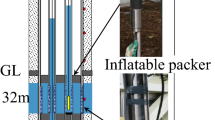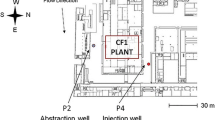Abstract
The quantitative prognosis and assessment of possible impacts of temperature changes in groundwater due to the geothermal use of the shallow subsurface in urban regions requires process-based numerical models of coupled non-isothermal groundwater flow, heat and mass transport processes and biogeochemical reactive processes. This work therefore aims at developing and implementing numerical methods as well as the required parameterizations to simulate the effects of temperature increases due to heat injection in a groundwater aquifer. Parameter and process models for fluid flow, solute transport, mass transfer processes between aqueous and non-aqueous phases, and microbial growth coupled to contaminant biodegradation are expressed as functions of temperature for this purpose. The developed model is implemented in the OpenGeoSys code and applied in a set of benchmark simulations, where thermal impacts of borehole heat exchangers (BHE) are simulated in an aquifer with a TCE contamination in a residual NAPL source zone. The thermal plumes emitted by the BHEs result in a focusing of groundwater flow due to a viscosity reduction of the heated water. The local increase in groundwater flow as well as an increase in TCE solubility with temperature leads to increased TCE emissions from the source zone. At the same time, increases in microbial growth rates allow for higher TCE degradation rates by reductive dechlorination. Results of the benchmark simulations allow insights into the interactions of the individual processes and potential benefits or conflicts of geothermal use of the subsurface and natural attenuation processes at contaminated sites. Also, the benchmark simulations can be used as test cases for intercomparison and validation of reactive transport codes.








Similar content being viewed by others
References
Ballarini E, Bauer S, Eberhardt C, Beyer C (2014a) Evaluation of the role of heterogeneities on transverse mixing in bench-scale tank experiments by numerical modeling. Groundwater 52:368–377. doi:10.1111/gwat.12066
Ballarini E, Beyer C, Bauer RD, Griebler C, Bauer S (2014b) Model based evaluation of a contaminant plume development under aerobic and anaerobic conditions in 2D bench-scale tank experiments. Biodegradation 25:351–371
Bauer S, Beyer C, Kolditz O (2006) Assessing measurement uncertainty of first-order degradation rates in heterogeneous aquifers. Water Resour Res 42:W01420
Bauer RD, Rolle M, Bauer S, Eberhardt C, Grathwohl P, Kolditz O, Meckenstock RU, Griebler C (2009) Enhanced biodegradation by hydraulic heterogeneities in petroleum hydrocarbon plumes. J Contam Hydrol 105:56–68
Bauer D, Marx R, Nußbicker-Lux J, Ochs F, Heidemann W, Müller-Steinhagen H (2010) German central solar heating plants with seasonal heat storage. Sol Energy 84:612–623
Bauer S, Beyer C, Dethlefsen F, Dietrich P, Duttmann R, Ebert M, Feeser V, Görke U, Köber R, Kolditz O, Rabbel W, Schanz T, Schäfer D, Würdemann H, Dahmke A (2013) Impacts of the use of the geological subsurface for energy storage: an investigation concept. Environ Earth Sci 70:3935–3943
Beyer C, Bauer S, Kolditz O (2006) Uncertainty assessment of contaminant plume length estimates in heterogeneous aquifers. J Contam Hydrol 87:73–95
Bonte M, van Breukelen BM, Stuyfzand PJ (2013a) Temperature-induced impacts on groundwater quality and arsenic mobility in anoxic aquifer sediments used for both drinking water and shallow geothermal energy production. Water Res 47:5088–5100
Bonte M, Röling WFM, Zaura E, van der Wielen PWJJ, Stuyfzand PJ, van Breukelen BM (2013b) Impacts of shallow geothermal energy production on redox processes and microbial communities. Environ Sci Technol 47:14476–14484
Boockmeyer A, Bauer S (2014) High-temperature heat storage in geological media: high-resolution simulation of near-borehole processes. Geotech Lett 4:151–156
Bradford SA, Abriola LM (2001) Dissolution of residual tetrachloroethylene in fractional wettability porous media: incorporation of interfacial area estimates. Water Resour Res 37:1183–1195
Brooks RH, Corey AT (1964) Hydraulic properties of porous media. Hydrol. Paper 3. Colorado State Univ., Fort Collins
Butscher C, Huggenberger P, Auckenthaler A, Bänninger D (2011) Risikoorientierte Bewilligung von Erdwärmesonden. Grundwasser 16:13–24
Carrayrou J, Kern M, Knabner P (2009) Reactive transport benchmark of MoMaS. Comput Geosci 14(3):385–392
Chen F, Freedman DL, Falta RW, Murdoch LC (2012) Henry’s law constants of chlorinated solvents at elevated temperatures. Chemosphere 86:156–165
Chiogna G, Eberhardt C, Grathwohl P, Cirpka OA, Rolle M (2009) Evidence of compound-dependent hydrodynamic and mechanical transverse dispersion by multitracer laboratory experiments. Environ Sci Technol 44:668–693
Cirpka OA, Frind EO, Helmig R (1999) Numerical simulation of biodegradation controlled by transverse mixing. J Contam Hydrol 40:159–182
Einstein A (1905) Über die von der molekularkinetischen Theorie der Wärme geforderte Bewegung von in ruhenden Flüssigkeiten suspendierten Teilchen. Ann Phys 17:549
Energiebilanzen AG (2013) Anwendungsbilanzen für die Endenergiesektoren in Deutschland in den Jahren 2011 und 2012 mit Zeitreihen von 2008 bis 2012. Arbeitsgemeinschaft Energiebilanzen e.V
Friis AK, Heimann AC, Jakobsen R, Albrechtsen HJ, Cox E, Bjerg PL (2007) Temperature dependence of anaerobic TCE-dechlorination in a highly enriched Dehalococcoides containing culture. Water Res 41:355–364
Gestis Substance Database (2016) http://www.dguv.de/ifa/GESTIS/GESTIS-Stoffdatenbank/index-2.jsp
Grathwohl P (1998) Diffusion in natural porous media topics in environmental fluid mechanics. Springer, New York
He W, Beyer C, Fleckenstein JH, Jang E, Kolditz O, Naumov D, Kalbacher T (2015) A parallelization scheme to simulate reactive transport in the subsurface environment with OGS#IPhreeqc 5.5.7-3.1.2 Geosci Model Dev 8:3333-3348
Heron G, Carroll S, Nielsen SG (2005) Full-scale removal of DNAPL constituents using steam-enhanced extraction and electrical resistance heating. Ground Water Monit Rem 25:92–107
Hiester U, Müller M, Koschizky HP, Trötschler O, Roland U, Holzer F (2013) Guidelines: in situ thermal treatment (ISTT) for source zone remediation of soil and groundwater. Helmholtz Centre for Environmental Research (UFZ)
Hindmarsh AC, Brown PN, Grant KE, Lee SL, Serban R, Shumaker DE, Woodward CS (2005) SUNDIALS: Suite of Nonlinear and Differential/Algebraic Equation Solvers. ACM Trans Math Softw 31:363–396
Hoes H, Patyn J, Lookman R (2012) The combination of aquifer thermal energy storage (ATES) and groundwater remediation. CityChlor, Utrecht
IAPWS (2007) Revised release on the IAPWS industrial formulation 1997 for the thermodynamic properties of water and steam. International Association for the Properties of Water and Steam, Lucerne
Illangasekare TH, Marr JM, Siegrist RL, Soga K, Glover KC, Moreno-Barbero E, Heiderscheidt JL, Saenton S, Matthew M, Kaplan AR, Kim Y, Dai D, Page JWE (2006) Mass transfer from entrapped DNAPL sources undergoing remediation: characterization methods and prediction tools. SERDP Project No. CU-1294, Colorado School of Mines. Golden, CO
Imhoff PT, Frizzell A, Miller CT (1997) Evaluation of thermal effects on the dissolution of a nonaqueous phase liquid in porous media. Environ Sci Technol 31:1615–1622
Islam MA, Edwards EA, Mahadevan R (2010) Characterizing the metabolism of Dehalococcoides with a constraint-based model. PLoS Comput Biol 6(8):e1000887. doi:10.1371/journal.pcbi.1000887
Jesußek A, Grandel S, Dahmke A (2013) Impacts of subsurface heat storage on aquifer hydrogeochemistry. Environ Earth Sci 69:1999–2012
Knauss KG, Dibley MJ, Roald LN, Mew DA, Aines RD (2000) The aqueous solubility of trichloroethene (TCE) and tetrachloroethene (PCE) as a function of temperature. Appl Geochem 15:501–512
Kolditz O, Bauer S (2004) A process-oriented approach to computing multi-field problems in porous media. J Hydroinf 6:225–244
Kolditz O, Ratke R, Diersch HJ, Zielke W (1998) Coupled groundwater flow and transport: 1. verification of variable density flow and transport models. Adv Water Resour 21:27–46
Kolditz O, Görke UJ, Shao H, Wang W (eds) (2012) Thermo-hydromechanical–chemical processes in porous media: benchmarks and examples (lecture notes in computational science and engineering). Springer, Berlin
Kolditz O, Görke UJ, Shao H, Wang W, Bauer S (eds) (2016) Thermo-hydro-mechanical–chemical processes in fractured porous media: modelling and benchmarking—benchmarking initiatives. Springer, Berlin
Krol MM, Johnson RL, Sleep BE (2014) An analysis of a mixed convection associated with thermal heating in contaminated porous media. Sci Total Environ 499:7–17
Kueper BH, Abbott W, Farquhar G (1989) Experimental observations of multiphase flow in heterogeneous porous media. J Contam Hydrol 5:83–95
Li D, Bauer S, Benisch K, Graupner BJ, Beyer C (2014) OpenGeoSys-ChemApp: a coupled simulator for reactive transport in multiphase systems—code development and application at a representative CO2 storage formation in Northern Germany. Acta Geotech 9:67–79
Lide DR (2005) CFC handbook of chemistry and physics, 85th edn. Taylor & Francis, Boca Raton
Miller DJ, Hawthorne SB (1999) Solubility of liquid organics of environmental interest in subcritical (hot/liquid) water from 298 K to 473 K. J Chem Eng 45:78–81
Molina-Giraldo N, Bayer P, Blum P (2011) Evaluating the influence of thermal dispersion on temperature plumes from geothermal systems using analytical solutions. Int J Therm Sci 50:1223–1231
Ni Z, van Gaans P, Smit M, Rijnaarts H, Grotenhuis T (2015) Biodegradation of cis-1,2-dichloroethene in simulated underground thermal energy storage systems. Environ Sci Technol 49:13519–13527
Nußbicker-Lux J (2010) Simulation und Dimensionierung solar unterstützter Nahwärmesysteme mit Erdsonden-Wärmespeicher. Dissertation, University of Stuttgart
Nußbicker-Lux J, Drück H (2012) Solare Nahwärmeversorgung in Crailsheim mit 7500 m2 Kollektorfläche. OTTI—22. Symposium Thermische Solarenergie 09.-11.05.2012, Kloster Banz
Park CH, Boettcher N, Wang W, Kolditz O (2011) Are upwind techniques in multi-phase flow models necessary? J Comput Phys 230:8304–8312
PlanEnergi (2013) Boreholes in Brædstrup. Final report
Popp S, Beyer C, Dahmke A, Bauer S (2015) Model development and numerical simulation of a seasonal heat storage in a contaminated shallow aquifer. Energy Procedia 76:361–370
Popp S, Beyer C, Dahmke A, Koproch N, Köber R, Bauer S (2016) Temperature dependent dissolution of residual non-aqueous phase liquids—model development and verification. Environ Earth Sci 75:953. doi:10.1007/s12665-016-5743-x
Rolle M, Eberhardt C, Chiogna G, Cirpka OA, Grathwohl P (2009) Enhancement of dilution and transverse reactive mixing in porous media: experiments and model based interpretation. J Contam Hydrol 110:130–142
Rosso L, Lobry JR, Bajard S, Flandrois JP (1995) Convenient model to describe the combined effects of temperature and pH on microbial growth. Appl Environ Microbiol 61:610–616
Sanner B, Kabus F, Seibt P, Bartels J (2005) Underground thermal energy storage for the German parliament in Berlin, system concept and operational experiences. World Geothermal Congress 2005, Antalya, Turkey
Schout G, Drijver B, Gutierrez-Neri M, Schotting R (2014) Analysis of recovery efficiency in high-temperature aquifer thermal energy storage—a Rayleigh-based method. Hydrogeol J 22:281–291
Sommer W, Drijver B, Verburg R, Slenders H, de Vries E, Dinkla I, Leusbrock I, Grotenhuis T (2013) Combining shallow geothermal energy and groundwater remediation. European geothermal congress 2013, Pisa, Italy
Steefel CI, MacQuarrie KTB (1996) Approaches to modeling of reactive transport in porous media. Rev Mineral Geochem 34:85–129
Steefel CI, Yabusaki SB, Mayer KU (2015) Reactive transport benchmarks for subsurface environmental simulation. Comput Geosci 19:439–443
Tsang CF, Stephansson O, Jing L, Kautsky F (2009) DECOVALEX project: from 1992 to 2007. Environ Geol 57(6):1221–1237
van Genuchten MT (1980) A closed form equation for predicting the hydraulic conductivity of unsaturated soils. Soil Sci Soc Am J 44:892–898
VDI (2010) Thermal use of the underground—fundamentals, approvals, environmental aspects. VDI 4640 Part I
Werth CJ, Cirpka OA, Grathwohl P (2006) Enhanced mixing and reaction through flow focusing in heterogeneous porous media. Water Resour Res 42:W12414
Wilke CR, Chang P (1955) Correlation of diffusion coefficients in dilute solutions. AIChE J 1:264–270
Xie M, Bauer S, Kolditz O, Nowak T, Shao H (2006) Numerical simulation of reactive processes in an experiment with partially saturated bentonite. J Contam Hydrol 83:122–147
Yaws CL (2009) Transport properties of chemicals and hydrocarbons—viscosity, thermal conductivity, and diffusivity of C1 to C100 organics and Ac to Zr inorganics. William Andrew Inc., Norwich
Zuurbier KG, Hartog N, Valstar J, Post VEA, van Breukelen BM (2013) The impact of low-temperature seasonal aquifer thermal energy storage (SATES) systems on chlorinated solvent contaminated groundwater: modeling of spreading and degradation. J Contam Hydrol 147:1–13
Acknowledgments
This work was performed within the ANGUS+ research project (Grant Number 03EK3022). We acknowledge funding of this project provided by the German Federal Ministry of Education and Research (BMBF) through Projektträger Jülich (PTJ) in the context of the energy storage initiative “Forschungsinitiative Energiespeicher.”
Author information
Authors and Affiliations
Corresponding author
Additional information
This article is part of a Topical Collection in Environmental Earth Sciences on “Subsurface Energy Storage”, guest edited by Sebastian Bauer, Andreas Dahmke, and Olaf Kolditz.
Electronic supplementary material
Below is the link to the electronic supplementary material.
Rights and permissions
About this article
Cite this article
Beyer, C., Popp, S. & Bauer, S. Simulation of temperature effects on groundwater flow, contaminant dissolution, transport and biodegradation due to shallow geothermal use. Environ Earth Sci 75, 1244 (2016). https://doi.org/10.1007/s12665-016-5976-8
Received:
Accepted:
Published:
DOI: https://doi.org/10.1007/s12665-016-5976-8




